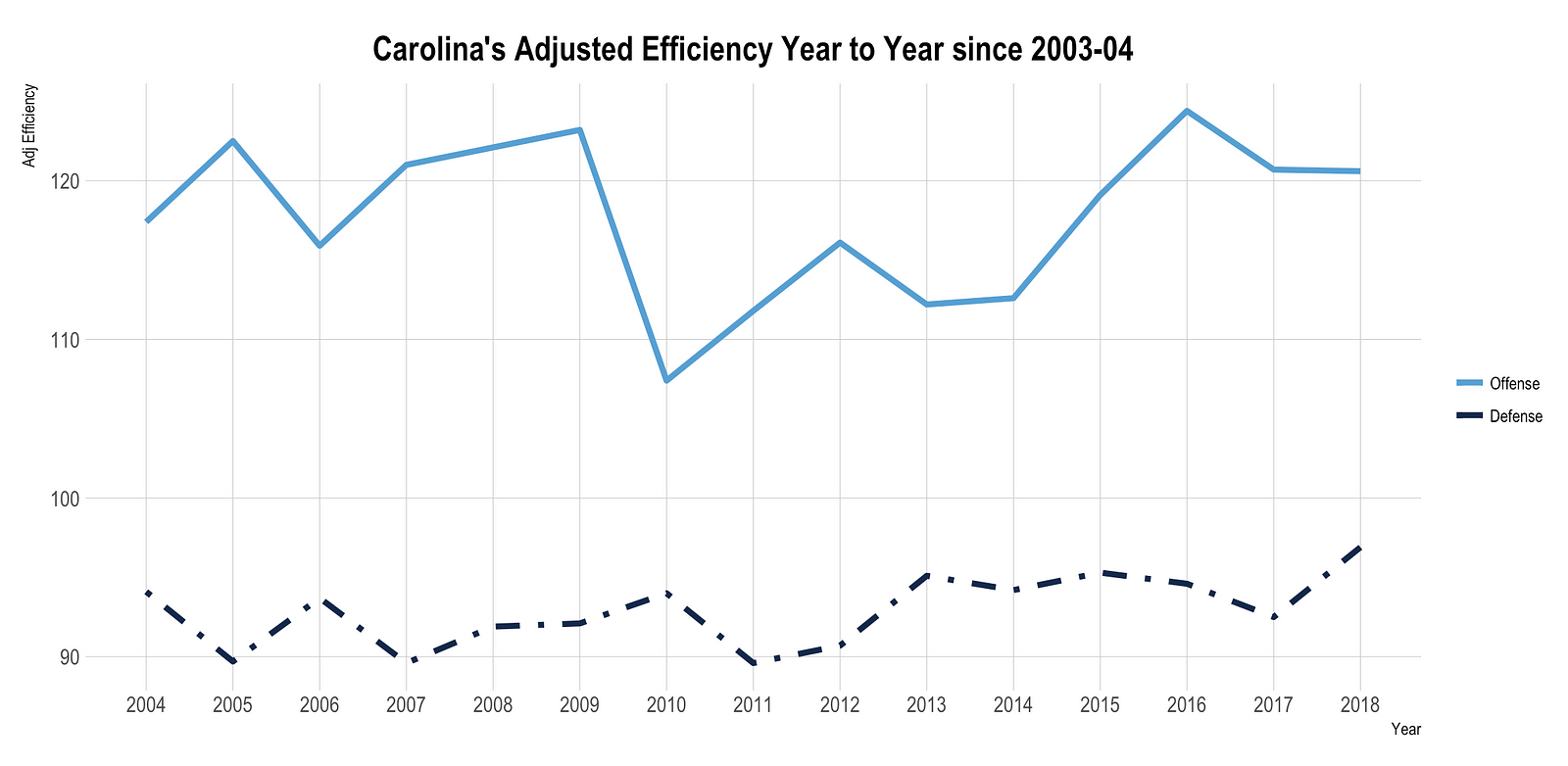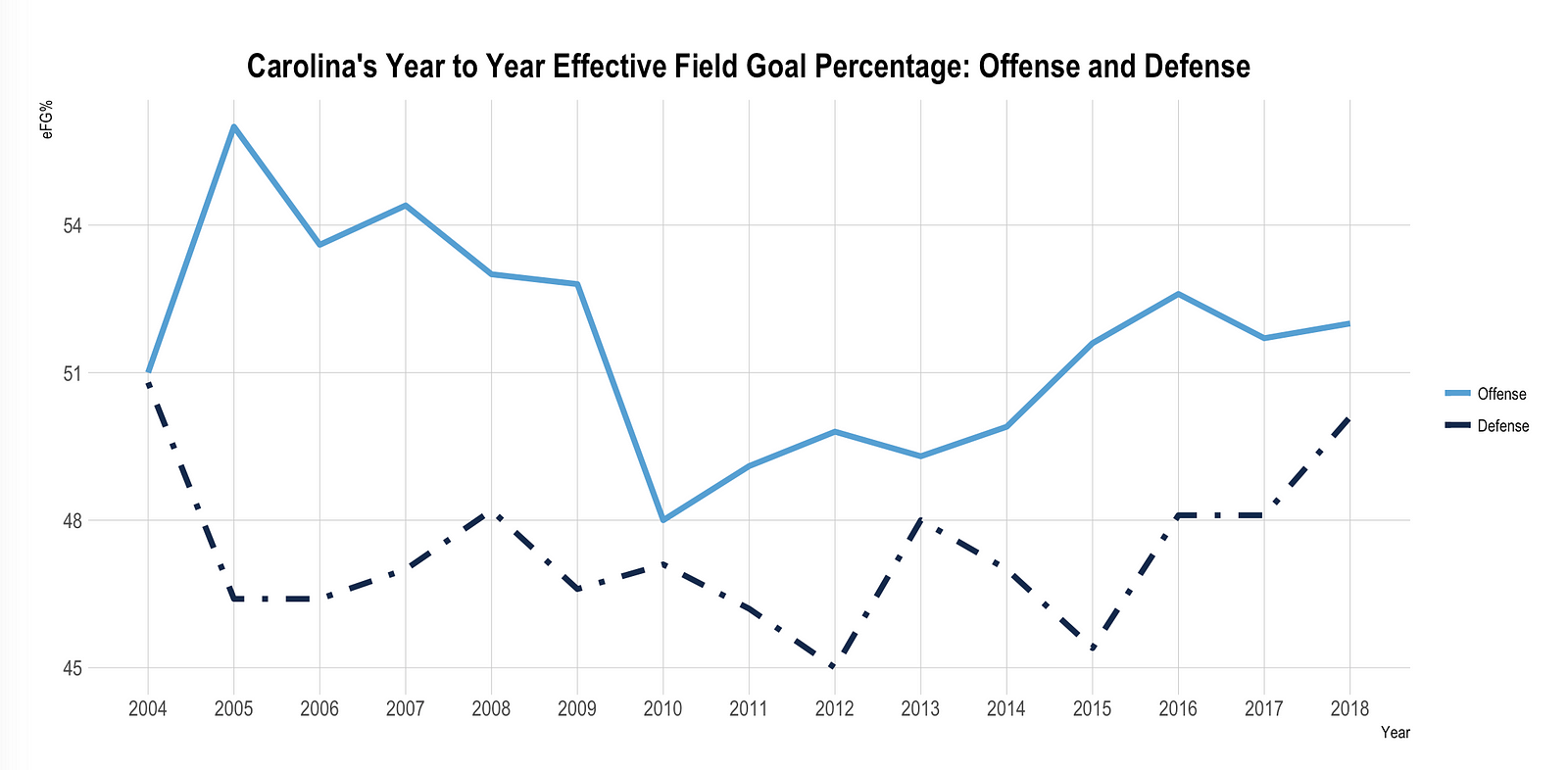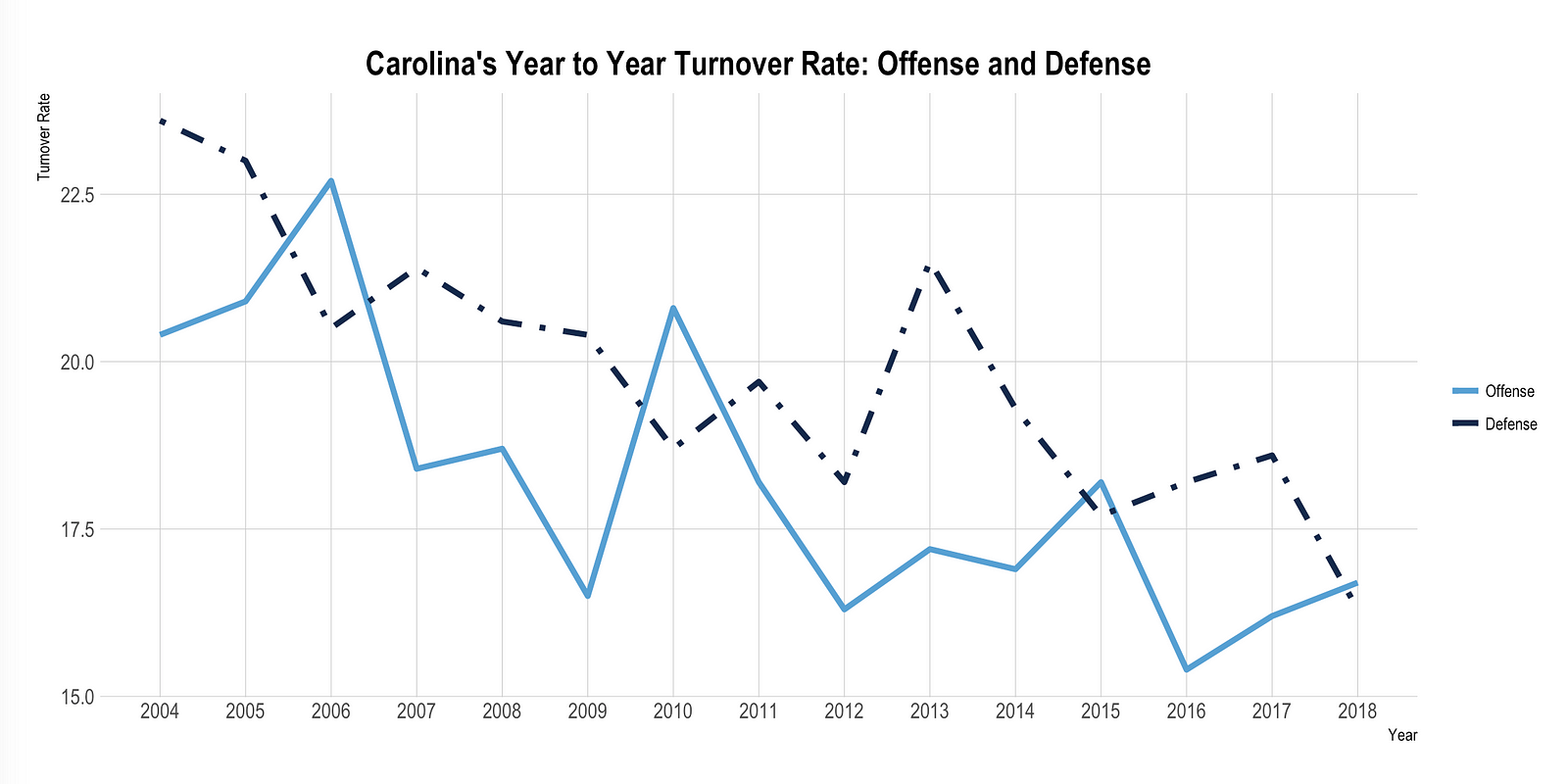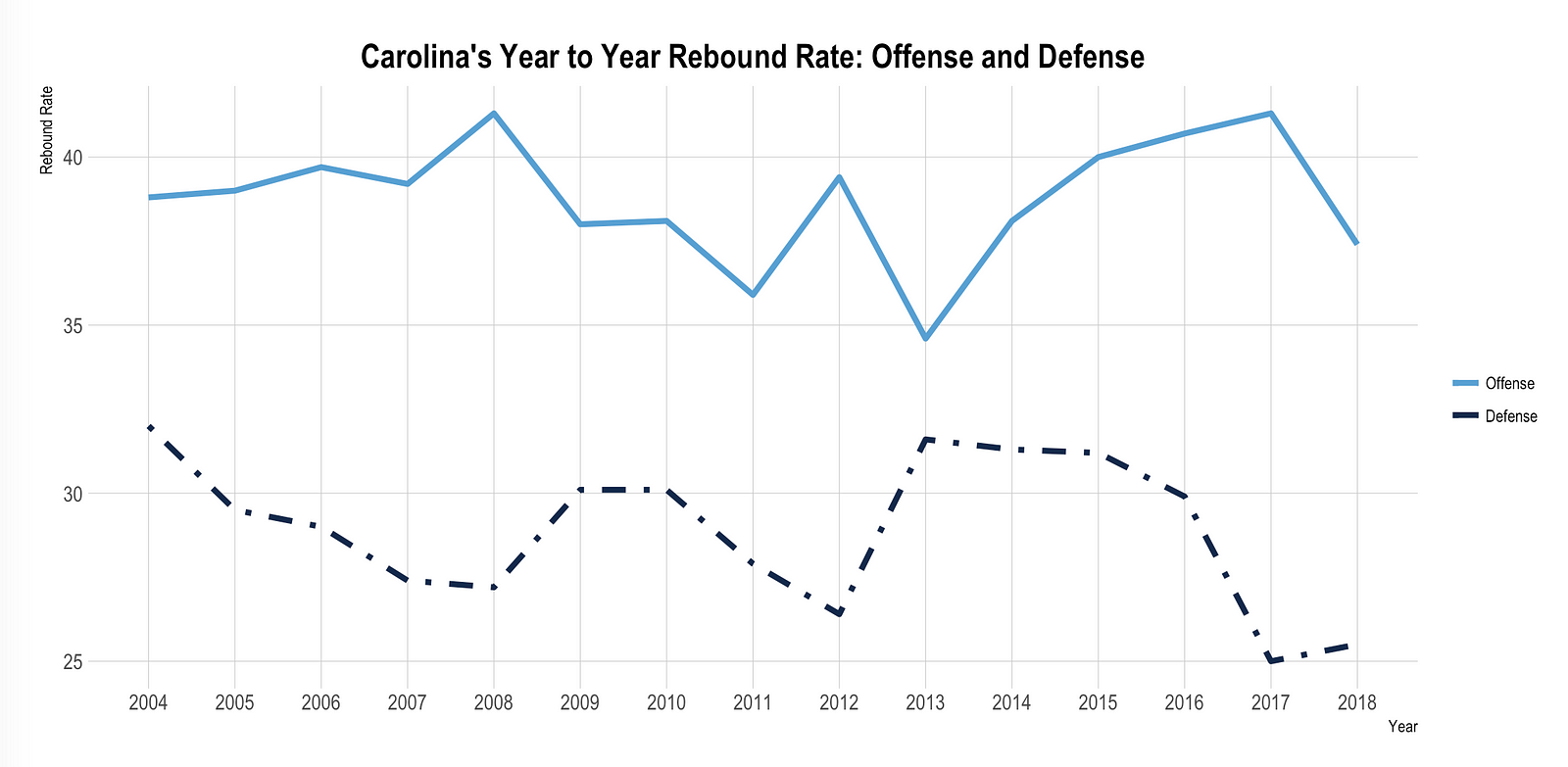In Retrospect, the 2017-18 Season
Fresh off the 2017 National Championship, North Carolina entered the 2017-18 season with a ton of uncertainty.
Carolina finished 26-11 overall, 11-7 in the ACC. The season ended in Charlotte in the second round of the NCAA Tournament.
A bit of perspective during the Roy Williams era.
After winning the 2005 National Championship, Carolina finished with a 23-8 record and its season ended in the second round of the NCAA Tournament.
The Tar Heels won the 2009 title, and the 2010 season ended in the NIT Finals. Carolina turned in a 20-17 record, including 5-11 in league play.
The 2017-18 season was a solid campaign. Temper your expectations.
Highs and lows all over the place, this season featured:
- the worst NCAA Tournament loss (20 points) by a Roy Williams’ coached team
- the first time Carolina beat Duke twice in the same season since 2009
- a three-game ACC losing streak, followed by a six-game win streak
- Carolina making the most three-pointers in a game under Roy Williams
- an improbable loss to Wofford at home
- the Tar Heels registering their worst shooting night in program history
Roller coaster.
From a statistical perspective, the 2017-18 squad was the worst defensive team in the past 15 seasons or in the Roy Williams era.
Carolina’s adjusted defensive efficiency was 96.9. The next worst season was the 2015 campaign (95.3) that ended with a Sweet 16 loss to Wisconsin.
The Tar Heels recorded an adjusted offensive efficiency of 120.6, seventh best in the past 15 seasons. This mark was nearly identical to Carolina’s 120.7 mark from a season ago.

So what’s the story behind these efficiency numbers?
The four factors are the building blocks of efficiency. These factors can help explain why Carolina was solid offensively, and not so hot on defense.
As a reminder, the four factors are:
-
Shooting: measured using effective field goal percentage, accounts for a 3-pointer being worth more than 2-pointer.
eFG% = (.5 * 3FGM + FGM) / FGA * 100 -
Avoiding turnovers: measured by what percent of a team’s possessions result in a turnover.
-
Rebounds: measured using the percentage of offensive rebounds a team grabs on its missed shots and free throws. Defensive rebounding or preventing offensive rebounds is equally important.
-
Getting to the foul line: measured using free throw rate, how often a team gets to the foul line, and keeps its opponent off the foul line.
FTRate = Free Throw Attempts / Field Goal Attempts
Shooting
Carolina’s offensive effective field goal percentage was 52.0%.
The Tar Heels made 305 three-point shots, and 1105 total field goals out of 2417 attempts.
eFG% = (.5 * 305 + 1105) / 2417 * 100 = 52.0
This mark is seventh highest under Roy Williams, and a touch better than a 51.7% mark from a season ago.
Roy Williams mentioned this group could be the best shooting team he ever coached. That statement never became true because this team was wildly inconsistent.
Carolina posted an eFG% lower than 45% seven times, and went 2-5 in those games. The Tar Heels also posted an eFG% higher than 60% six times, with a 5-1 record in those contests.
In comparison, the 2016-17 team recorded an eFG% lower than 45% ten times with a 5-5 record in those games. It went 4-0 when posting an eFG% above 60%.
Tar Heel opponents recorded an eFG% of 50.1%, the second worst mark under Roy Williams. The only other season is was higher was in the 2004 campaign (50.8%).
Carolina opponents made 357 three-point shots, and 972 field goals out of 2297 field goal attempts.
eFG% = (.5 * 357 + 972) / 2297 * 100 = 50.1
Teams made 38% of their three-point shots against Carolina. That’s astonishingly high, and the worst mark under Roy Williams.
Carolina simply could not afford a poor shooting night. Most teams can’t afford a poor shooting night either, but especially this Carolina squad because of their weak defense.
Carolina was 5-7 this season when posting a lower eFG% than its opponent. The squad from a season ago was 12-7 when posting a lower eFG% than its opponent. They did it 19 times, and won 12 of those games!

Carolina relied on the three-point shot for its points. With no traditional post presence, the Tar Heels scored 53% of their points on two-point shots and just 16.7% from foul shots.
Carolina scored 30.3% of points from three-point shots, the most ever under a Roy Williams led team.
And opponents distribution was similar too. Carolina’s opponents were so effective from behind the three-point line that they scored 39.5% of their points from there. This number is ninth highest in the nation as of March 20, and of course, the highest its ever been under Roy Williams.
Here’s a look at year-by-year point distribution on offense and defense:
The most important factor of efficiency is a team’s ability to shoot. And while Carolina could turn in an effective shooting night, its defense often wasn’t good enough to stop other teams from doing the same.
Avoiding turnovers
16.7% of Carolina’s offensive possessions ended in a turnover. This number is similar to the last couple seasons, and not too far off from the best turnover rate of 15.4 under Roy Williams in the 2016 season.
Another remarkable example of highs and lows. Carolina recorded only two total turnovers in a home win over Duke this season, good for an amazing 3.3 turnover rate. And it also turned it over on 32% of its possessions in a loss in Charlottesville against Virginia.
At times, Carolina was careless with the ball, however, this team avoided empty possessions at a respectable clip.

The defensive end is such a different story. Opponents only turned it over on 16.3% of their possessions, the fewest amount under Roy Williams. The next closest was a 17.7 turnover rate for opponents during the 2015 season.
While Carolina played an incredibly difficult schedule and its opponents were talented, the Tar Heels struggled to force turnovers or benefit even from careless play from opponents.
Without a true rim protector, opponents capitalized on Carolina’s poor on ball defense and took over 40% of their shots from behind the three-point line. It often looked that Carolina over helped trying to compensate for its lack of post presence and failed to deflect many passes that could translate into turnovers.
Rebounds
The glass was a huge concern entering the season. It’s also the priority when it comes to a Roy Williams led team.
Carolina rebounded 37.4% of their missed shots, a number that would rank 13th out of the past 15 seasons. This number also ranked third overall in the country.
One overlooked trend is teams are rebounding a fewer percentage of their misses across college basketball. While the 37.4 rate doesn’t look great compared to past Carolina teams, it’s still an incredible rate nationally given the Tar Heels lack of size.
It won Carolina games this season when it didn’t make a ton of shots. The second chance points were huge in certain games for this team.
Yet another wild example of highs and lows. Carolina rebounded 42.6% of their missed shots in a home win over Duke. The Tar Heels shot the ball much worse than the Blue Devils, but attempted 15 more shots to earn a 4-point win.
When Texas A&M absolutely dominated Carolina in the NCAA Tournament, the backboards had a lot to do with it.
UNC's lowest offensive rebounding percentages under Roy:
— Lauren Brownlow (@lebrownlow) March 19, 2018
3/18/18, 17.3%, Texas A&M (L)
12/12/15, 16.7%, Texas (L)
2/14/16, 4.3%, Pitt (W)
The Tar Heels snagged only 17.3% of their missed shots. And that’s in a game where they missed 52 total shots!
On the defensive end, opponents only gathered 25.5% of their missed shots. That’s good for the second best mark ever under Roy Williams. Only last season’s mark of 25.0 was better.

This could possibly be a red herring given the success teams had shooting against Carolina. And also fitting a similar trend that Division-I teams rebounding rate is down overall. It’s possible too many teams chose not to crash the glass against Carolina for fear of what this squad could do in transition.
While Luke Maye gets credit for his offense, his individual defensive rebounding rate of 22.8 ranked in the top-100 in the country at the end of his season. He was terrific on the defensive glass, and with more minutes for Sterling Manley next season, that duo could do wonders keeping teams off the boards in the future.
Getting to the foul line
Roy Williams has always said he wants his teams to make more free throws than their opponents attempt. The last time this statement was true was in the 2012 season.
Carolina made 503 free throws this season. Its opponents attempted 597 foul shots. A margin of -94.
As we continue to beat this drum, without polished post players, Carolina didn’t draw a ton of fouls and get to the line as often this season. A free throw rate of 28.0 is the lowest ever under Roy Williams, just narrowly beating out the 28.2 rate from the 2012-13 squad.
And here’s a silly exercise. Carolina attempted 677 free throws as a team this season in 37 games. Did you know Tyler Hansbrough attempted 377 free throws on his own in the 2007-08 season in 39 total games?
The table below shows Carolina’s made free throws to opponents attempted free throws year-by-year:
The -94 margin is actually the slimmest it has been since the 2012 season when Carolina had a +100 margin.
So why is that margin so tiny?
Even though Carolina didn’t get to the line a lot, it did a good job keeping opponents off the foul line too. It’s defensive free throw rate of 26.0 is good for sixth best over the past 15 seasons.
Before this season, Luke Maye committed 5.1 and 5.8 fouls per 40 minutes as a sophomore and freshman. In increased minutes, Maye committed only 3.1 fouls per 40 minutes this season.
Opponents often didn’t need to beat Carolina inside to win games either. Remember opponents attempted 40% of their shots from three-point land, and made 38% of those shots.
So while Carolina was weak inside, it was also weak on the perimeter, so getting to the line wasn’t all that necessary to defeat this team.
So what the hell does this all mean?
This Carolina team was far from traditional. It relied on the three-point shot more than ever, and turned in some remarkable offensive performances. Both bad and good.
The 2017-18 team was the worst defensive squad in the Roy Williams era. It had flashes of slowing down opponents, but the defense was never something the team could hang its hat on.
This meant while Carolina could outscore opponents per usual under Roy Williams, it couldn’t win many games in an ugly fashion. The margin of error was razor thin. And to be a great team, you have be able to overcome a poor shooting performance.
26-11 and a second round exit in the NCAA Tournament. That’s the outcome. The result. But how it happened was much more fascinating to follow along.
And where do they go from here?
You can debate starting lineups now until November. But three areas you wonder about moving forward are point guard, defensive play, and overall improvement of the current roster.
Point guard: Joel Berry II and Theo Pinson are done. That’s a massive void in leadership, and production.
Seventh Woods career hasn’t gone as planned thus far. This doesn’t mean Woods isn’t full of potential and capable of turning his career around.
The most amount of minutes Woods has ever played in a game is 22. What does it look like when he’s playing more than that every single game?
A lot of uncertainty there, especially, given Jalek Felton is no longer at the university too.
Can Andrew Platek play reserve minutes as a point guard?
Will Leaky Black or Coby White be able to fill that role?
Theo Pinson ended his career with 536 rebounds and 417 assists. No other Carolina player has ever had 500+ rebounds with 410+ assists (Walter Davis had 670/409).
— Adrian Atkinson (@FreeportKid) March 18, 2018
A true UNC unicorn in terms of his rebounding/playmaking combination.
Pinson was a true unicorn for Carolina. He will be missed all over the place, including distributing the ball.
Can this team continue to share and move the ball as well as they did this past season without Pinson?
Defensive play: Carolina can’t expect to win many games if its defense performs the same next season. It was downright awful throughout this season.
Can this team improve defensively with younger players injecting into the lineup?
And will more competent post play translate into fewer reasons to over help and leave open shooters?
The defense has to get better. It’s that simple. But that doesn’t mean it will be easy for this group.
Overall improvement: Seniors Kenny Williams and Luke Maye. These two have improved so much already in their careers, and you expect them to do so next season too.
It might sound odd, however, the best way Maye gets better might not be through his own doing. But through his teammates improvement.
Maye isn’t a player that bangs inside. He’s a stretch-four that can shoot. If he plays alongside better big men, it’s completely possible his game is even more effective. Woulda, coulda, shoulda, but Maye might have been devastating in the high-low with Tony Bradley.
It’s almost a similar case for Williams too. He can be a dynamite scorer. A great shooter, and the best defender on a team of bad defenders. Williams’ defense would only improve if his teammates commit to getting better around him.
Sterling Manley, Garrison Brooks, and Brandon Huffman will have a year of experience. These three will be relied upon to help on both ends of the floor.
Can this trio of bigs become consistent?
Will Cameron Johnson choose to play another year?
Next season’s junior class of Seventh Woods and Brandon Robinson will be critical. Woods is going to see more time. Can Robinson improve his shot, defense, and get stronger?
Can Andrew Platek improve defensively and earn more minutes?
And will the incoming freshmen live up to the hype? Nassir Little, Leaky Black, and Coby White. Will a fourth classmate be joining them?
If all the answers to these questions are yes, then it likely means Carolina will have something they lacked this past season. A reliable bench.
This season’s Carolina team was different. High highs. Low lows. And that’s what makes it so much fun to follow along.